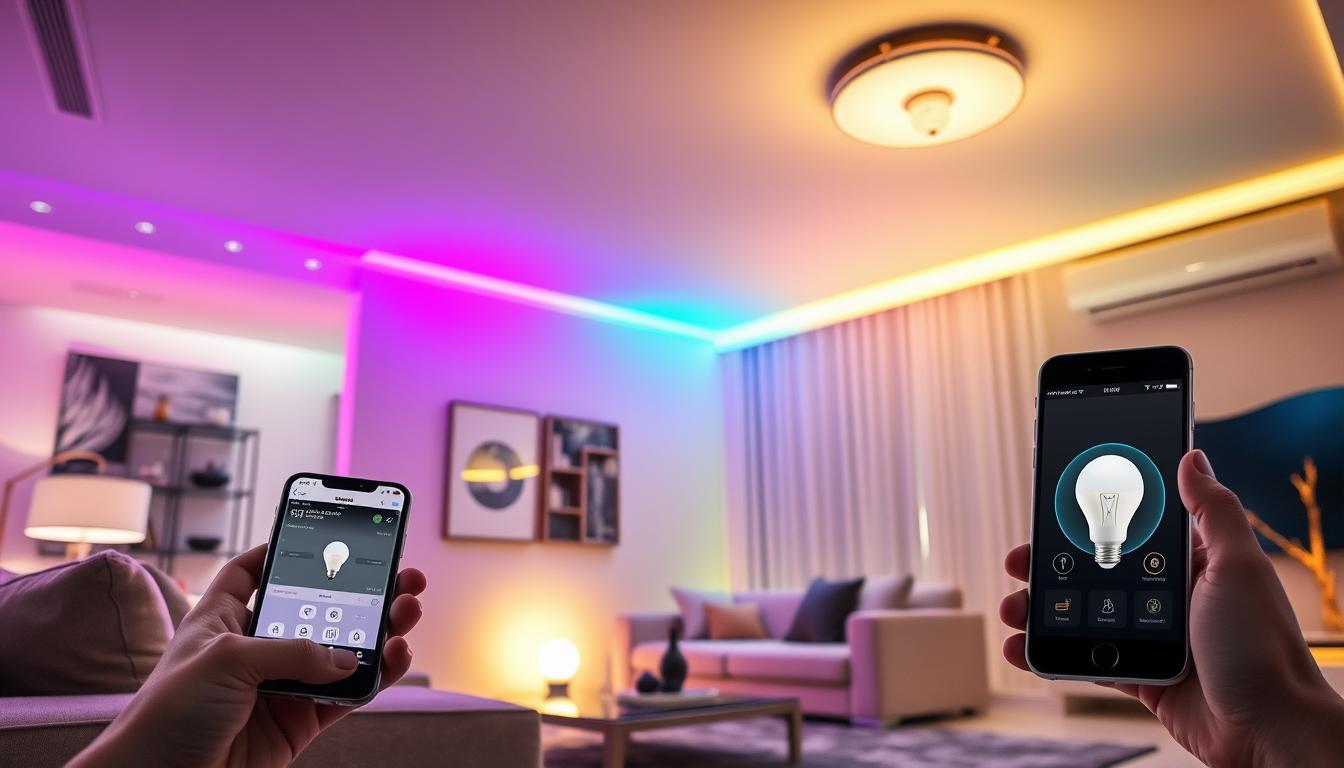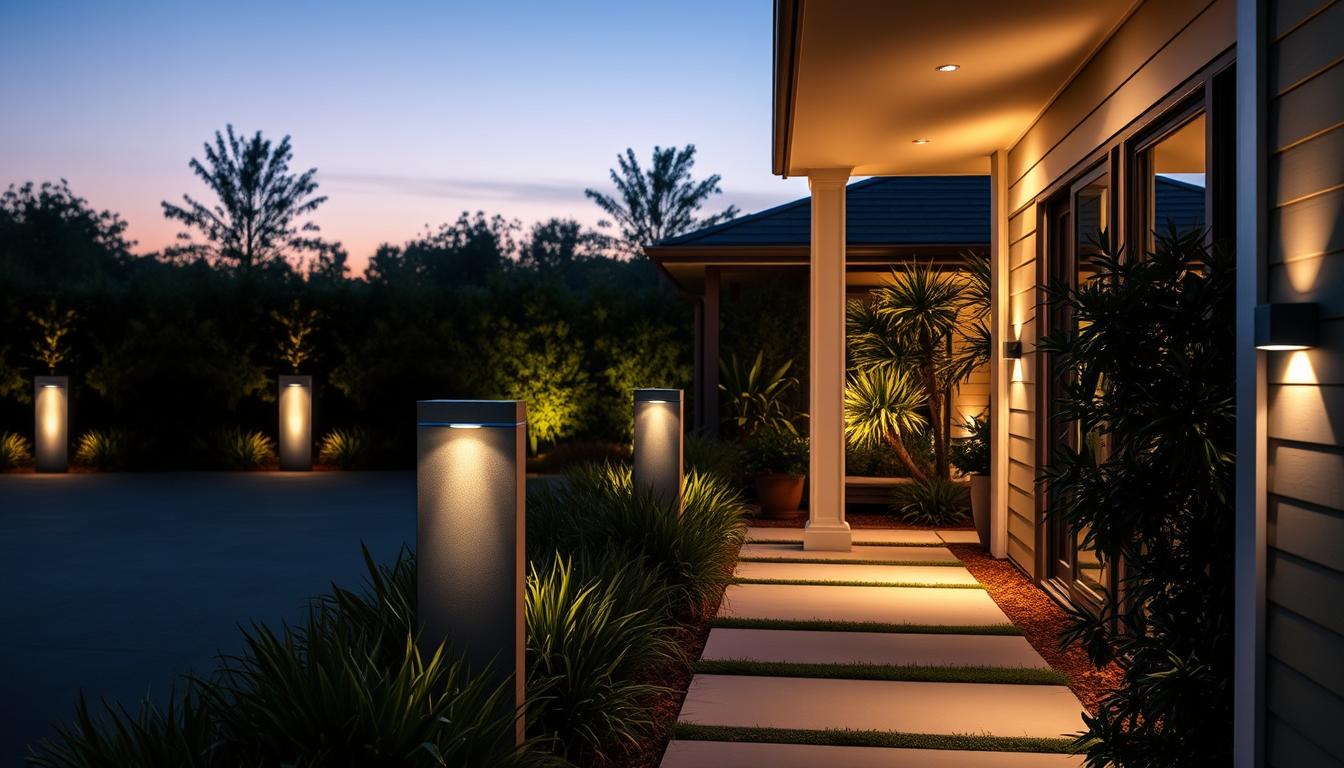Smart lighting is changing how we live in our homes, making them smarter and easier to use. It combines home automation and wireless control. This guide will show you how smart lighting can make your home more efficient and comfortable.
Imagine controlling your home’s lights with just your voice or a smartphone tap. Smart lighting lets you do this, making it easy to adjust your home’s mood and save energy. It helps create a cozy and eco-friendly living space.
Exploring smart lighting, you’ll learn about its parts and how they work. We’ll cover smart bulbs, switches, and control systems. You’ll see how these can be added to your home. Smart lighting can brighten up a room or manage lights all over your house, meeting your needs.
Key Takeaways
- Smart lighting systems provide wireless control and home automation capabilities
- Smart lighting can enhance the ambiance and energy efficiency of your home
- Smart bulbs and switches are key components of smart lighting systems
- Smart lighting can be controlled using voice commands or smartphone apps
- Smart lighting systems can be integrated with other smart home devices and platforms
- Smart lighting offers a range of benefits, including increased convenience and energy savings
Understanding Smart Lighting Systems
Smart lighting systems are changing how we use light at home. They use smart bulbs that can be controlled with lighting apps. This lets homeowners set up their own lighting scenes and adjust brightness and color.
These systems can learn what you like and adjust to your habits. They work with other smart devices, making your home smarter. You can control them with voice commands or set them to turn on and off automatically.
Smart lighting saves energy, makes life easier, and boosts safety. You can turn lights off from anywhere, saving money and energy. It also works with motion sensors for extra security.
There are many smart lighting options out there. Brands like Philips and LIFX offer features that work with different lighting apps and connected lighting systems. Choosing the right one can make your home more comfortable and efficient.
Benefits of Transforming Your Home with Smart Lighting
Smart lighting can make your home more convenient, energy-efficient, and cozy. With home automation, you can control your lights from anywhere. This is great for making it seem like someone’s home when you’re not.
Smart lighting works well with other smart devices like thermostats and security cameras. For example, lights can turn on when you enter a room or when it gets dark. Smart switches let you control many lights at once, making it easy to change your home’s lighting.
- Energy efficiency: Smart lighting can help you reduce your energy consumption by turning off lights when they’re not in use.
- Cost savings: By reducing your energy consumption, you can save money on your energy bills.
- Enhanced ambiance: Smart lighting can help you create the perfect ambiance for any occasion, whether it’s a romantic dinner or a movie night.
Smart lighting makes your life easier and more fun. It lets you control your lights from anywhere and automate your lighting. This way, you can create a smart home that fits your needs and style.
| Benefit | Description |
|---|---|
| Energy Efficiency | Reduce energy consumption by turning off lights when not in use |
| Cost Savings | Save money on energy bills by reducing energy consumption |
| Enhanced Ambiance | Create the perfect ambiance for any occasion with smart lighting |
Essential Smart Lighting Components and Hardware
Creating a smart lighting system requires several key components. These include smart bulbs, smart switches, and smart lighting hubs. They work together for a seamless experience. You can control your lights with voice commands, schedules, and more.
Smart bulbs are energy-efficient and last a long time. They can change color and brightness. Smart switches let you control your lights without replacing bulbs. They can be controlled with voice commands, making it easy to turn lights on and off.
Smart lighting hubs and bridges are also important. They connect your devices and enable voice control. They act as a central hub, letting you control all your smart lighting devices from one place. With the right components, you can have a smart lighting system that’s both functional and convenient.
Using smart lighting components offers many benefits. Here are a few:
- Energy efficiency: Smart bulbs and switches can help you save energy and lower your bills.
- Convenience: With voice control and scheduling, you can control your lights from anywhere, anytime.
- Customization: Smart lighting components let you tailor your lighting to your needs and preferences.
Setting Up Your First Smart Lighting System
Setting up a smart lighting system might seem hard, but it’s actually easy. First, pick the right parts like smart bulbs, switches, and a hub. Wireless control is key, letting you manage your lights from anywhere.
Think about what you want from your connected lighting. Do you want to control lights one by one or together? Also, do you want to link your lights with other smart home devices? Knowing this helps you pick the best parts for you.
Here’s how to set up your smart lighting system:
- Choose your components, including smart bulbs, switches, and a hub
- Install your components, following the manufacturer’s instructions
- Configure your settings, including setting up wireless control and connected lighting
By following these steps, you can make your home smart and easy to live in. With wireless control and connected lighting, you can change the mood of your home with just a tap.
Advanced Smart Lighting Control Methods
Smart lighting systems offer many advanced control methods. This makes it easy to manage and customize your lighting. You can control your lights from anywhere with lighting apps.
These apps have features like scheduling, scene creation, and energy monitoring. They help you optimize your lighting and save energy.
Voice control is another convenient method. It lets you adjust your lighting with simple voice commands. This is great when used with smart speakers or virtual assistants like Amazon Alexa or Google Assistant.
Motion sensors also play a big role in advanced smart lighting control. They detect movement and turn lights on or off automatically. This adds convenience and saves energy.
By adding motion sensors to your smart lighting system, you can create automated scenes. These scenes adapt to your daily routines and preferences.
Mobile App Control Features
- Scheduling and timer functions
- Scene creation and customization
- Energy monitoring and reporting
Voice Command Integration
Voice control makes adjusting your lighting easy. It’s a favorite among smart home fans. By integrating voice control with your smart lighting, you get a seamless and user-friendly experience.
Motion Sensors and Automation
Motion sensors enable automated lighting control. They add convenience and save energy. By adding motion sensors to your smart lighting, you can create customized scenes that fit your daily life.
Creating Perfect Ambiance with Smart Lighting Scenes
With smart lighting, you can make your home feel just right for any event. Whether it’s a dinner party or a movie night, smart lighting scenes can set the mood. You can change the color, brightness, and dimming to create a special atmosphere.
Connected lighting makes your home feel seamless and automated. You can make scenes for different times, like a romantic dinner or a cozy evening. The options are endless, and you can control it all from home.
- Movie nights: dim red lights to create a cozy atmosphere
- Dinner parties: warm white lights to create a welcoming ambiance
- Relaxation: soft blue lights to promote calmness
Using smart lighting to create the perfect ambiance makes your home smarter and more connected. It enhances your living experience.
Integration with Other Smart Home Systems
Creating a seamless smart home experience is all about integration. Smart lighting can work with other smart systems like security cameras, thermostats, and door locks. This makes your home automated and easy to manage. For example, you can set lights to turn on when you enter or leave a room.
Platforms like Samsung SmartThings, Apple HomeKit, and Amazon Alexa support smart lighting integration. They let you control many smart devices from one place. This makes managing your smart home simple. You can set up routines that turn on lights when you enter a room or adjust them based on the time.
To enhance your smart home, try creating custom automation routines. For instance, a “goodnight” scene can turn off lights, lock doors, and adjust the thermostat with one command. By integrating smart lighting with other systems, you get a smart home that’s convenient, energy-efficient, and secure.
Maximizing Energy Efficiency Through Smart Lighting
Smart lighting systems bring many benefits, like convenience and energy savings. They help homeowners cut down on energy use and lower bills. This not only reduces environmental impact but also saves money over time.
Smart lighting systems can track energy use in real-time. Homeowners can see where they can use less energy and make changes. Some systems even offer detailed reports to help optimize energy use.
Energy Monitoring Features
Energy monitoring is key in smart lighting systems. It lets homeowners track energy use and spot trends. This helps them make smart choices to use less energy. Some features include:
- Real-time energy usage tracking
- Historical energy usage data
- Energy usage alerts and notifications
- Personalized energy-saving recommendations
Cost-Saving Strategies
Smart lighting systems also offer ways to save money. They help homeowners use less energy and lower bills. Some strategies include:
Using smart bulbs that turn on and off automatically. They use less energy when not in use. This can save a lot of money, even more with other energy-saving practices.
By using these strategies and features, homeowners can save a lot on energy. Smart lighting makes it easy to cut down on waste, lower bills, and help the planet.
| Smart Lighting Feature | Energy Efficiency Benefit | Cost Savings |
|---|---|---|
| Smart Bulbs | Automated on/off scheduling | Up to 80% energy savings |
| Energy Monitoring | Real-time energy usage tracking | Up to 30% energy savings |
| Smart Lighting Controls | Dimming and brightness adjustment | Up to 50% energy savings |
Troubleshooting Common Smart Lighting Issues
Smart lighting aims for a seamless, automated home life. Yet, like any tech, problems can pop up. It’s key to fix common issues to keep your connected lighting system running smoothly.
Here are some steps to tackle common problems:
- Check the power supply and ensure all devices are properly connected
- Restart your smart lighting hub or bridge to reset the system
- Update your smart lighting app to the latest version
By following these steps, you can quickly fix common smart lighting issues. This way, you can enjoy the perks of connected lighting in your home. Always check your user manual or the manufacturer’s website for more troubleshooting tips.
With a bit of patience and practice, you’ll master fixing common smart lighting problems. This ensures your system stays convenient and energy-saving for your home.
| Common Issue | Solution |
|---|---|
| Bulb not turning on | Check power supply and replace bulb if necessary |
| Connection issues | Restart smart lighting hub or bridge |
Conclusion: Embracing the Future of Home Lighting
Smart lighting is changing how we light our homes, bringing in a new age of home automation and saving energy. The future of home lighting looks even brighter, with new tech and ideas ready to change how we use our homes.
With voice commands and easy connections to other smart home systems, the options for smart lighting are vast. By jumping into this new world, homeowners can make their homes more personal, easy to use, and energy-smart. The future of home lighting is bright, and those who dive in will enjoy a smart, dynamic home.



